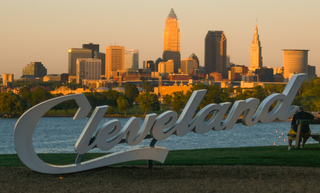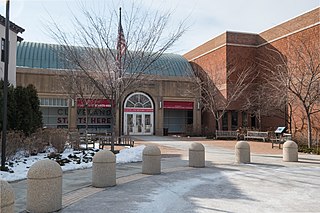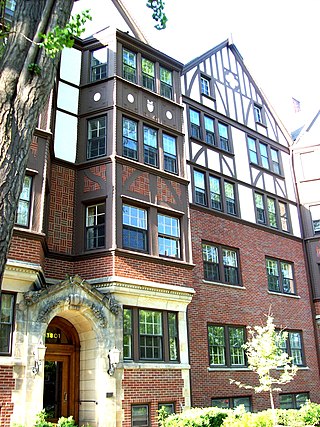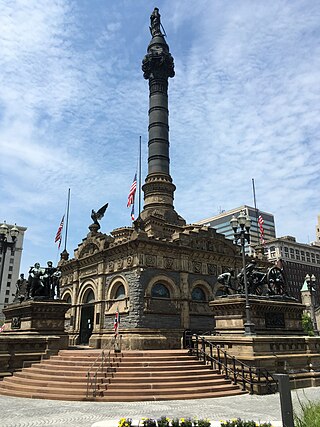
Cleveland, officially the City of Cleveland, is a city in the U.S. state of Ohio and the county seat of Cuyahoga County. Located in Northeast Ohio along the southern shore of Lake Erie, it is situated across the U.S. maritime border with Canada and lies approximately 60 miles (97 km) west of Pennsylvania. Cleveland ranks as the most populous city on Lake Erie, the second-most populous city in Ohio, and the 54th-most populous city in the U.S. with a 2020 population of 372,624. The city anchors the Cleveland metropolitan area, the 33rd-largest in the U.S. at 2.18 million residents, as well as the larger Cleveland–Akron–Canton combined statistical area, the most populous in Ohio and the 17th-largest in the country with a population of 3.63 million in 2020.

The Connecticut Western Reserve was a portion of land claimed by the Colony of Connecticut and later by the state of Connecticut in what is now mostly the northeastern region of Ohio. The Reserve had been granted to the Colony under the terms of its charter by King Charles II.

The Western Reserve Historical Society (WRHS) is a historical society in Cleveland, Ohio. The society operates the Cleveland History Center, a collection of museums in University Circle.

University Circle is a district in the neighborhood of University on the East Side of Cleveland, Ohio. It is home to the Cleveland Museum of Art, Severance Hall, the Cleveland Institute of Art, the Cleveland Cinematheque, Case Western Reserve University, the Cleveland Institute of Music, the Museum of Contemporary Art Cleveland, the Cleveland Botanical Garden, historic Lake View Cemetery, the Cleveland Museum of Natural History, and University Hospitals/Case Medical Center.

Collinwood is a historical area in the northeast part of Cleveland, Ohio. Originally a village in Euclid Township, it was annexed by the city in 1910. Collinwood grew around the rail yards of the Lake Shore and Michigan Southern Railway and is divided by these same tracks into the neighborhoods of North Shore Collinwood and Collinwood–Nottingham. Collinwood was identified as one of America's Best Secret Neighborhoods by Travel + Leisure in 2008.

The written history of Cleveland began with the city's founding by General Moses Cleaveland of the Connecticut Land Company on July 22, 1796. Its central location on the southern shore of Lake Erie and the mouth of the Cuyahoga River allowed it to become a major center for Great Lakes trade in northern Ohio in the early 19th century. An important Northern city during the American Civil War, Cleveland grew into a major industrial metropolis and a gateway for European and Middle Eastern immigrants, as well as African American migrants, seeking jobs and opportunity.

Buckeye–Shaker is a neighborhood on the East Side of Cleveland, Ohio. It encompasses two sub neighborhoods: in its south and west, the old Buckeye neighborhood; and in its northeast, the Shaker Square neighborhood, which is centered on an historic shopping district and an eponymous rapid transit station, located at the intersection of Shaker and Moreland Boulevards, on the light rail line that connects the city of Shaker Heights to downtown Cleveland. From the early to mid-20th century, the Buckeye Road neighborhood was known as "Little Hungary", serving as the historic heart of Cleveland's Hungarian community, which at one time was the largest in the world outside of Hungary and for years has been almost completely African-American. Shaker Square, continues to be known as one of Cleveland's most notable neighborhoods, in terms of shopping, dining, architecture, the education of its residents, participation in civic life, diversity, and quality of living.

Broadway–Slavic Village is a neighborhood on the Southeast side of Cleveland, Ohio. One of the city's oldest neighborhoods, it originated as the township of Newburgh, first settled in 1799. Much of the area has historically served as home to Cleveland's original Czech and Polish immigrants. While demographics have shifted over the decades, the largest part of Broadway today, Slavic Village, is named for these earlier communities.

The Cuyahoga County Soldiers' and Sailors' Monument is a major Civil War monument in Cleveland, Ohio, honoring the more than 9,000 individuals from Cuyahoga County who served the Union throughout the war. It was dedicated on July 4, 1894, and is located on the southeast quadrant of Public Square in Downtown Cleveland. It was designed by architect and Civil War veteran Levi Scofield, who also created the monument's sculptures. The monument is regularly open to the public, free of charge.

Luna Park was a trolley park in Cleveland, Ohio, from 1905 to 1929.

Forest Hill Park is an historic urban park that was a portion of John D. Rockefeller's estate, located in East Cleveland and Cleveland Heights, Ohio. Two-thirds of the park lie in East Cleveland, and the remaining third is in Cleveland Heights. The 248-acre (1.00 km2) park has six baseball diamonds, six lit tennis courts and walking trails that have retained the natural green space as intended by John D. Rockefeller Jr., who deeded the park to the two cities in 1936. Albert Davis Taylor was the park's landscape architect. It is the largest single body of green space between two large metroparks on the far east and west sides of Cleveland.

Tremont is a neighborhood on the West Side of Cleveland, Ohio. Listed on the National Register of Historic Places, the district sits just south of the Ohio City neighborhood. It is bounded by the Cuyahoga Valley to the north and east, MetroHealth medical center to the south, and West 25th Street and Columbus Road to the west.

Charles Frederick Schweinfurth was an American architect in Cleveland, Ohio. His brother Julius Schweinfurth was also an architect and they did some projects as a partnership.

Hough is a neighborhood situated on the East Side of Cleveland, Ohio. Roughly two square miles, the neighborhood is bounded to Superior and Euclid Avenue between East 55th and East 105th streets. Placed between Downtown Cleveland and University Circle, Hough borders Fairfax and Cedar–Central to the South and Glenville and St. Clair–Superior to the North. The neighborhood became a target for revitalization during the mid-20th century, after the 1966 Hough Riots.

Rockefeller Park is a city park named in honor of oil magnate John D. Rockefeller Sr., located in Cleveland, Ohio. Part of the Cleveland Public Parks District, Rockefeller Park is immediately adjacent Wade Park to the southeast, and across Euclid Ave on its northwest border. Besides the distinction of being the largest park located completely within city limits, Rockefeller Park is a link in a chain of parkland that connects the heights region of the eastern suburbs to the city's lakefront. Following the path of Martin Luther King Jr. Drive and spanning a large section of Cleveland's East Sides, the park runs in a northwesterly path between suburban Shaker Heights, bisecting the University Circle neighborhood and terminating at Gordon Park on the city's lakefront, opened to the public in 1897. The park was dramatically expanded during the 1930s with labor provided by the Works Progress Administration. Landmarks found in Rockefeller Park include two separate entries on the National Register of Historic Places: one for its architecturally historic bridges, and one for its Cultural Gardens.

Wade Park is a park in the University Circle neighborhood of Cleveland, Ohio. Wade Park today largely serves as the campus for the Cleveland Museum of Art, the Cleveland Botanical Garden, and the Cleveland Museum of Natural History, as well as Wade Lagoon, which faces the Museum of Art from the south end of the park. Though not technically a historical landmark itself, the park falls within the eponymous Wade Park historical district and serves as a backdrop for most of its registered buildings.
Vijaya Lakshmi Emani was an Indian American social activist known for her work against domestic violence, and was a civic leader among the Indian American community in Cleveland, Ohio. Starting with Northeast Ohio Telugu Association, followed by the Federation of Indian Community Associations and with Greater Cleveland Asian Community, she was the president of the Federation of India Community and a board member of the Federation of India Community Associations (FICA). She was posthumously awarded the Presidential Citizens Medal, the second-highest United States civilian award, in 2011.

The demographics of Cleveland have fluctuated throughout the city's history. From its founding in 1796, Cleveland's population grew to 261,353 by 1890, and to 796,841 by 1920, making it the fifth largest city in the United States at the time. By 1930, the population rose to 900,429 and, after World War II, it reached 914,808. Due to various historical factors including deindustrialization, suburbanization, and urban sprawl, Cleveland's population began decreasing in the 1960s. By 1970, the city's population was 750,903. By 1980, it was 573,822 and it had lost its position as one of the top 10 largest cities in the U.S. By 2020, the population had further fallen to 372,624. Beginning in 2018, the city's population began to flatten, after decades of decline. Additionally, between 2010 and 2020, several neighborhoods within Cleveland saw a significant population increase, most notably Downtown, but also University Circle and several West Side neighborhoods.

Commodore Oliver Hazard Perry Monument is a war monument in Cleveland, Ohio that commemorates Oliver Hazard Perry and his victory at the Battle of Lake Erie in the War of 1812. Erected at the center of the city's Public Square in 1860, its Perry statue by sculptor William Walcutt was Ohio's first monumental sculpture.

The following is a bibliography of Cleveland, Ohio. It includes selected publications specifically about the city, Cuyahoga County, and the Greater Cleveland Metropolitan Area.

![The Croatian Cultural Garden is one of the many gardens found in the Cleveland Cultural Gardens and the baptismal font is located in the Croatian garden. The font represents Croatia's conversion to Christianity and is a replica of Prince Viseslav's baptismal font. The font has six sides and is inscribed: "This font receives the weak to enlighten them. Here they are purged of their sins which they received from their first parents, to become Christians, salutary [sic] confessing the Eternal Trinity. This work was skillfully made by priest John at the time of Prince Viseslav, out of piety but to honor Saint John the Baptist, to mediate for him and his protege." Croatian Cultural Gardens' Baptismal Font.jpg](http://upload.wikimedia.org/wikipedia/commons/thumb/0/0a/Croatian_Cultural_Gardens%27_Baptismal_Font.jpg/269px-Croatian_Cultural_Gardens%27_Baptismal_Font.jpg)




















